Recording, Mixing And Mastering With M/S Tutorial
Having grown up in a world in which a pair of left- and right-hand monitors represents a complete 180-degree stereophonic soundstage, you can see why another way of exploring stereo sound – namely, M/S (Mid/Side) – could initially seem bewildering. More than being just another way of looking at a stereo image, though, M/S has […]
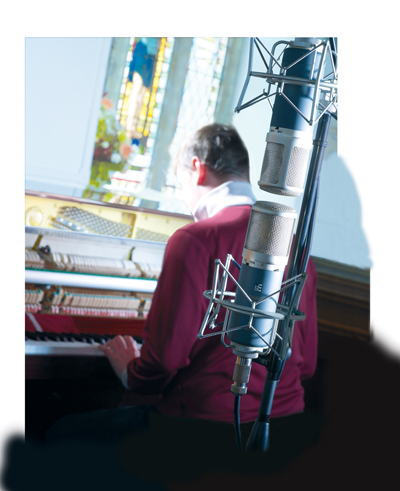

Having grown up in a world in which a pair of left- and right-hand monitors represents a complete 180-degree stereophonic soundstage, you can see why another way of exploring stereo sound – namely, M/S (Mid/Side) – could initially seem bewildering.
More than being just another way of looking at a stereo image, though, M/S has the potential to transform the way in which you record, mix and master a piece of music, offering a plethora of new sonic opportunities that conventional left/right stereo can never quite muster. But what are the principles behind M/S and, more importantly, how can you go about using M/S recording and processing techniques in a range of production environments?
Decoding Stereo
Arguably the best way of understanding M/S – and why it’s so important – is to take a step back to understand the fudge that is conventional left/right stereo. In effect, L/R stereo is one of the greatest illusions of the 20th century, with just two speakers being placed a few metres apart from one another to create a complete 180-degree soundstage. What’s particularly interesting about a L/R speaker setup is our perception of the ‘centre’ of the mix – a place where all the key instruments of a track (including vocals, bass and kick) reside. Despite the fact that there’s no ‘centre’ speaker, we perceive these signals as emanating from a point that’s equidistant between the left- and right-hand speakers – which, if you think about it, is an impressive feat of illusion!
The trick behind this ‘ghost’ centre is easy to see via the pan pot on a mixer, as this illusionary middle of the soundstage is created when a signal is sent to both left and right speakers at equal amplitude. In theory, therefore, we can say that our ‘middle’ is formed by the sum of both the left and right channels – something that can be created in the studio by mono’ing a L/R mix.
Having understood the concept of mid signal created by a sum of left and right, the next step is to consider the side signal, formed from the difference between the left- and right-hand channels. The derivation of the side signal can be tricky to understand, but essentially it says that the two extremities of the soundstage – the ‘width’, in other words – are formed by the differences between the left- and right-hand channels. Difference, of course, is vital to the concept of stereo – that some signals are stronger in one speaker than another, for example, or that there are timing delays between a signal arriving at either ear – so it makes sense that this can be expressed as an entity in its own right. Remember, of course, that ‘shared’ information is already carried in the mid signal, so we’re now interested only in the differences between the left and right channels.
If the derivation of M/S sounds a bit confusing, it’s worth experimenting with a simple M/S encoding/decoding plug-in – Brainworx’s free bx_solo, for example – and listening to some music through it. Solo the mid channel and you’ll hear the lead vocal, bass, kick and snare all relatively loud. Solo the side, though, and the lead vocal will almost disappear (other than the shimmer of its stereo reverb, of course), with the off-centre instruments – guitars, overheads and keyboards – now becoming evident. Having heard L/R stereo for so long, it’s a revelatory experience, and highlights the intriguing way in which M/S can dissect a stereo signal.
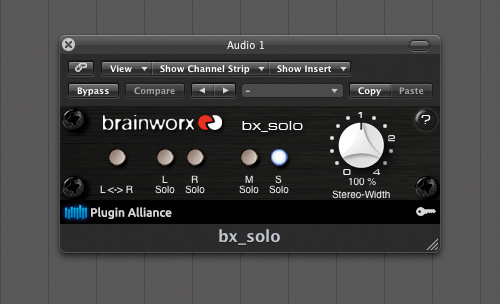
Freeware M/S plug-ins such as Brainworx’s bx_solo can be a great way of initially hearing (and understanding) the wonders of M/S.
Advantage M/S
The ability to listen to stereo in a new and illuminating way is exciting, but it isn’t the end of what M/S can offer in respect to music production. Indeed, there’s a host of new techniques that M/S offers, starting from the process of recording and stretching through the arts of mixing and mastering. Although there are many dedicated M/S products – including various decoders and encoders as well as M/S-dedicated plug-ins – you’ll also find that a lot of techniques can be achieved using the existing equipment and software in your studio.
Arguably one of the most important M/S techniques is the process of M/S recording, which illustrates many of the benefits and practises behind M/S. As you’d expect, M/S recording is a variant of stereo recording, but one that offers interesting advantages over X-Y, near-coincident and A-B spaced-omni techniques. Principally speaking, conventional L/R stereo recording techniques suffer from a degree of mono incompatibility, either through phase inconsistancies between the capsules, or more directly by the fact that none of the capsules points directly at the sound source. In short, it’s the opposite of the ‘ghost centre’ between two speakers – except that this time the ghost is the sound source itself.
To capture an instrument in M/S stereo we need two mics. The first mic, pointing directly at the sound source, forms the mid channel, and is usually set in the form of a cardioid or omni pickup pattern. The first principal benefit of M/S is easy to see in that we have a capsule pointing directly on-axis with the sound source, arguably making M/S the ultimate choice in terms of mono compatibility. So, if you want a mono version, pick the mid channel. What’s more intriguing is the side channel mic, which is in the form of a figure-8 pickup pattern placed at 90 degrees to the mid mic.
Interestingly, the side mic is now picking up stereo information in relation to polarity, so that an instrument placed at the left-hand side of the microphone, for example, will have a different polarity from an instrument arriving on the right-hand side. Of course, none of this will make any auditory sense at the moment as our two signals need to be decoded before we can audition their true sonic effectiveness. Put bluntly, all we are hearing at the moment are two slightly different signals – mid and side, in other words – rather than a proper stereo soundstage
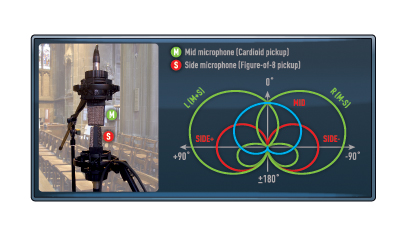
Recording in M/S necessitates two mics: a forward-facing cardioid for the mid channel, and a figure-8 mic orientated at 90 degrees for the side channel.
Decoding The Enigma
In the case of M/S decoding, we can carry out the process manually or use a plug-in decoder to achieve the process more efficiently. With manual decoding, the mid channel is simply panned to the centre of the mix, so that an equal proportion of the signal is sent to the left- and right-hand speakers. The side channel, however, needs to be split down two mixer channels, which is best achieved in a DAW by copying the side channel across two track lanes, with one of the sides phase-inverted. The phase inversion effectively restores the ‘polarity effect’ of instruments to either side of the capsule when the recording took place, and when mixed with the mid signal creates a complete 180-degree stereo soundstage.
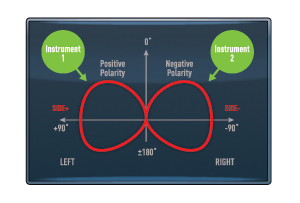
The ‘stereo’ image of the side channel is picked up by the relative polarity, so that instruments to the left have a positive polarity and sources to the right have a negative polarity.
As well as the aforementioned mono compatibility, the process of decoding also perfectly illustrates the other principal benefit of M/S – that of controllable stereo width. By varying the levels of the two side channels we can effectively widen or narrow the width of the stereo soundstage – either closing it up (with less of the side channel) or widening it (by pulling down the mid channel accordingly). Of course, if you’re using a dedicated decoding plug-in it’s highly likely that you’ll have specific controls that relate to the final width of the stereo soundstage.
One of the particularly interesting points about M/S is how it opens up the potential to record instruments that you’d traditionally capture in mono as true stereo recordings. Any form of solo instrument (or, indeed, vocals) can often benefit from M/S recording, with the mid channel effectively working as the principal component alongside a spare figure-8 microphone running as the side.
Unlike other stereo arrangements, the two microphones of an M/S arrangement don’t need to be matched, so you can afford to use your preferred vocal mic for the mid channel. Although you won’t capture a great deal of stereo imagery, you’ll often notice a pleasant ‘air’ around the instrument, particularly in respect to the subtle pick-up of stereo room acoustic, as well as the usual body and presence you’d expect from an instrument being recorded on-axis.
The Vertical Dimension
Beyond recording in stereo, it’s also possible to choose the M/S domain as a means of applying signal processing, both in the case of mixing and mastering. The questions, of course, are why you might choose to move into the M/S domain, and what potential benefits can M/S processing deliver?
To a large extent, one of the principal benefits of processing in the M/S domain – in other words, taking an existing sound from L/R stereo to M/S, processing it, then returning it to L/R stereo – is that of controlling and manipulating stereo width. Ultimately, L/R is extremely limited in respect to control of width: other than rebalancing the left and right signals or adjusting the two respective pan pots, there’s little that you can actually achieve. By making a distinction between the mid and side, though, we have a tangible and meaningful way of playing with width, which is why so many stereo adjustment tools are basically repackaged forms of M/S.
Moving more towards the mastering side of things, the other principal benefit of M/S processing is its ability to dissect a complete mix in a more musically relevant way. Whereas a multiband compressor slices a track into three or four distinct ‘horizontal’ frequency bands, an M/S-based processor can dissect a track into three distinct ‘vertical’ bands, covering the centre of the mix and its two sides. Looked at from a musical perspective, there are some key differences between the respective use of the mid and side in a mix, much more than the almost arbitrary use of conventional left and right. As we saw earlier on with the bx_solo plug-in example, most tracks fall into the pattern of having principal ‘driving’ instruments in the centre of the mix, while the colour, detail and texture arguably fall towards the sides of the mix.

The majority of stereo width-adjustment plug-ins use M/S principles, such as Waves’ S1 Stereo Imager shown here.
The M/S Domain
As we’ve hinted at already, we need to use the combination of an M/S encoder and M/S decoder as a means of moving in and out of the M/S domain. In theory, you can create an M/S encoder in much the same way as we created a decoder for our example of M/S recording (although the encoder principally works in reverse, of course). However, it’s much easier at this point to use a dedicated encoder/decoder so that you can quickly move a L/R signal into the M/S domain and back again. The clear benefit here, though, is that any plug-in – assuming that it has two discrete channels, of course – can be easily called into service as an M/S processor. Placed between an appropriate encoder and decoder, therefore, left simply becomes mid, while the right channel works with the side signal.
Having made the trip into M/S, the trick now is to know what you can meaningfully achieve by processing a signal in this way. In some respects it can take time to understand how M/S works, although you’ll soon be able to identify the principal instruments and sounds that can be found in the mid and side of a mix. Principally speaking, your main signal-processing tools are the traditional insert effects – particularly compression and equalisation – although you can also achieve some interesting results using distortion and saturation as well.
As with compression and equalisation in a conventional L/R mix, the trick with M/S processing is to understand how the additional processing changes how the sounds are presented in the mix or the final master. Starting with EQ, we can already deduce some important factors, particularly if you’ve been deconstructing some existing material using an M/S encoder/decoder. The mid channel, for example, often has a bias towards bass and midrange frequencies, although, of course, it isn’t entirely devoid of treble. The side channel, on the other hand, tends to favour treble and air, especially given the detailed and colourful sounds that often reside in this area.
In applying EQ, therefore, there’s often a tendency to play towards this existing balance, arguably lifting the bass in the mid channel, for example, while adding a touch of lightness and air to the side. From a mastering perspective, it’s also good to be able to differentiate how you equalise the mid and side channels. For example, a slightly sibilant vocal could be tamed by some dynamic EQ on the mid channel, without affecting the hi-hat and overheads that reside safely in the side channel. Ultimately, M/S equalisation gives you more control to affect the specific sounds, instruments or sonic elements you want to modify rather than the broader strokes of L/R equalisation.
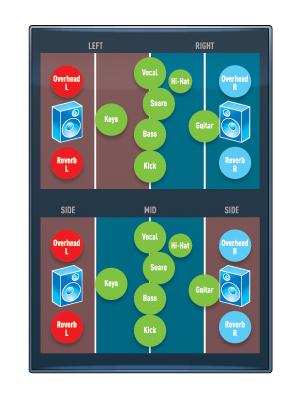
Two contrasting ways of dividing a stereo image: conventional L/R stereo slices the principal instruments in two, whereas M/S creates a more musical division of the instruments.
M/S Squash
Following the same logic as M/S equalisation, we can now start to see how M/S compression could be used and abused to create some powerful sonic effects. Again, the trick is to differentiate the use of sound energy between the mid and side components of a stereo signal. As we saw before, the mid contains a lot of the power behind a piece of music – given its use of bass and the fact that a lot of the principal instruments reside here. Adding more compression, therefore, can be a useful way of increasing the power and drive of a mix without necessarily taking the whole of the recording with you. On the flipside, applying compression on the side channels can be a good way of enhancing and accentuating the details of a recording, especially smaller sounds like hi-hats, reverbs and stereo keyboards, which can easily get lost in the energy created by the centre of the mix
As well as compression, you can also achieve some interesting results using saturation and distortion effects in a similar way. Again, given the power that resides in the mid channel, you can achieve some interesting results by adding a touch of saturation in this area, especially given the way in which it can bolster the bass end of the mix. If you’re a guitarist and enjoy creating powerful ‘wraparound’ distortion effects, then M/S also offers some interesting possibilities given the option to differentiate between distortion applied to the mid and side channels. In this case, a heavy distortion applied to the side channel really helps to widen the guitar sound, whereas a heavier distortion treatment on the mid channel helps to focus the guitar on the centre of the soundstage.
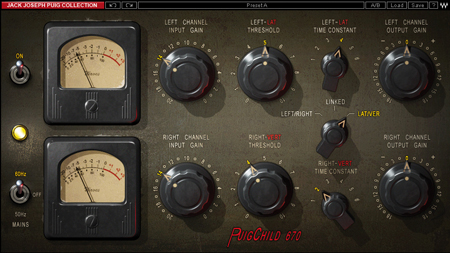
The classic Fairchild 670 compressor features a Lateral/Vertical compression mode, which is a form of M/S used for cutting stereo vinyl.
Super Stereo
More than being just a way of recording and processing a sound, M/S really does have the potential to transform your working process and how you envisage sound behaving in the stereo dimension. The technology and theories behind M/S might not be as intuitive as L/R stereo, but it’s certainly an incredibly powerful and logical way of dividing up a stereo image, especially when you consider how instruments are usually arranged across a soundstage. Indeed, after just a few minutes’ playing with an M/S encoder or decoder, you’ll soon realise why many engineers and producers have said that M/S stereo is one of the best-kept secrets in mastering and production circles.
Hopefully, the examples that we’ve highlighted here provide a good kick-start to your auditory journey through M/S, as well as identifying the principal signal-processing techniques you might choose to apply in the M/S domain. Of course, this is only the beginning of what you can achieve, especially when you start to consider some of the extreme and unusual forms of effects processing and how these might behave in the M/S dimension. For now, though, start listening to the powerfully insightful view M/S provides and you’ll soon see why L/R seems such a primitive way of handling a 180-degree stereo soundstage.